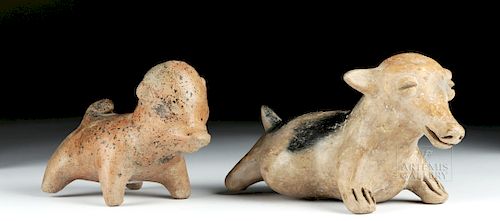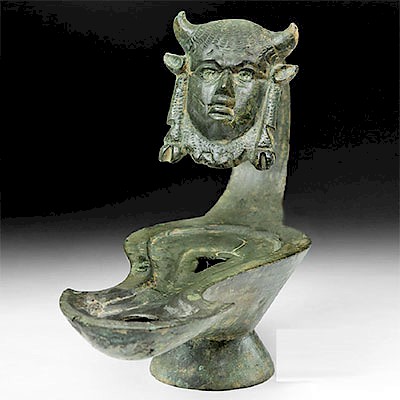Lot of 2 Exhibited Nayarit & Jalisco Pottery Puppy Dogs
Lot 133
About Seller
Artemis Gallery
686 S Taylor Ave, Ste 106
Louisville, CO 80027
United States
Selling antiquities, ancient and ethnographic art online since 1993, Artemis Gallery specializes in Classical Antiquities (Egyptian, Greek, Roman, Near Eastern), Asian, Pre-Columbian, African / Tribal / Oceanographic art. Our extensive inventory includes pottery, stone, metal, wood, glass and textil...Read more
Estimate:
$1,100 - $1,650
Absentee vs Live bid
Two ways to bid:
- Leave a max absentee bid and the platform will bid on your behalf up to your maximum bid during the live auction.
- Bid live during the auction and your bids will be submitted real-time to the auctioneer.
Bid Increments
| Price | Bid Increment |
|---|---|
| $0 | $25 |
| $300 | $50 |
| $1,000 | $100 |
| $2,000 | $250 |
| $5,000 | $500 |
| $10,000 | $1,000 |
| $20,000 | $2,500 |
| $50,000 | $5,000 |
| $100,000 | $10,000 |
| $200,000 | $20,000 |
About Auction
By Artemis Gallery
Sep 27, 2018
Set Reminder
2018-09-27 10:00:00
2018-09-27 10:00:00
America/New_York
Bidsquare
Bidsquare : Antiquities | Asian | Ethnographic
https://www.bidsquare.com/auctions/artemis-gallery/antiquities-asian-ethnographic-3469
Featuring classical antiquities, ancient and ethnographic art from cultures encompassing the globe. Artemis Gallery info@artemisgallery.com
Featuring classical antiquities, ancient and ethnographic art from cultures encompassing the globe. Artemis Gallery info@artemisgallery.com
- Lot Description
Pre-Columbian, West Mexico, Jalisco, Protoclassic period, ca. 100 BCE to 250 CE; Nayarit, Chinesco, Protoclassic period, ca. 100 BCE to 250 CE. A lovely ensemble of two hollow-cast and highly-burnished pottery puppies, each with four attenuated legs and a perky tail. The smaller Nayarit Chinesco dog is depicted standing with a stocky torso, tail curled up onto its back, and an opening atop the minimalist head, all colored with a pale-orange slip. The larger Jalisco tan-gray hued dog rests upon a corpulent belly with splayed back legs, with dark fire-clouded areas on its back, and an indented head that humorously resembles an anteater. A lovely study on different forms of playful pottery puppy dogs! Size of largest (tan-gray color): 7.625" L x 4.125" H (19.4 cm x 10.5 cm).
Scholars know of at least two types of Jalisco/Colima dogs, one to be fattened up and ritually sacrificed or eaten and one to serve as a watchdog and healer of the ill. This plump hairless canine known as a Chichi or Escuintla is thought to be related to the Chihuahua or Mexican Hairless also known as the Xoloitzcuintle. The Xolo dog was named for the deity Xolotl, the God of the Underworld, and believed to guide the deceased as they journeyed to the afterlife. Jalisco and Nayarit figures such as this one were buried in shaft tombs to protect the deceased and provide sustenance for eternity.
Provenance: private New York, New York, USA collection; ex-private Nevada, USA collection; ex-Dr. David Harner collection, Arkansas, USA, acquired 1950s-1960s, items #131 and no #. Exhibited at the Marjorie Barrick Museum, University of Nevada, Las Vegas (UNLV), 1980s and late 1990s
All items legal to buy/sell under U.S. Statute covering cultural patrimony Code 2600, CHAPTER 14, and are guaranteed to be as described or your money back.
A Certificate of Authenticity will accompany all winning bids.
We ship worldwide and handle all shipping in-house for your convenience.
#133917Smaller dog has ancient losses to both ears, and repair to tail with minute chips along break line. Both pieces have surface wear and abrasions commensurate with age, light roughness to undersides of bodies and feet, small nicks to rim of head opening, and a couple of dark areas of discoloration to larger dog. Light earthen deposits on both dogs with great mineral deposits on smaller dog.Condition
- Shipping Info
-
All shipping is handled in-house for your convenience. Your invoice from Artemis Gallery will include shipping calculation instructions. If in doubt, please inquire BEFORE bidding for estimated shipping costs for individual items.
-
- Buyer's Premium



 EUR
EUR CAD
CAD AUD
AUD GBP
GBP MXN
MXN HKD
HKD CNY
CNY MYR
MYR SEK
SEK SGD
SGD CHF
CHF THB
THB

















